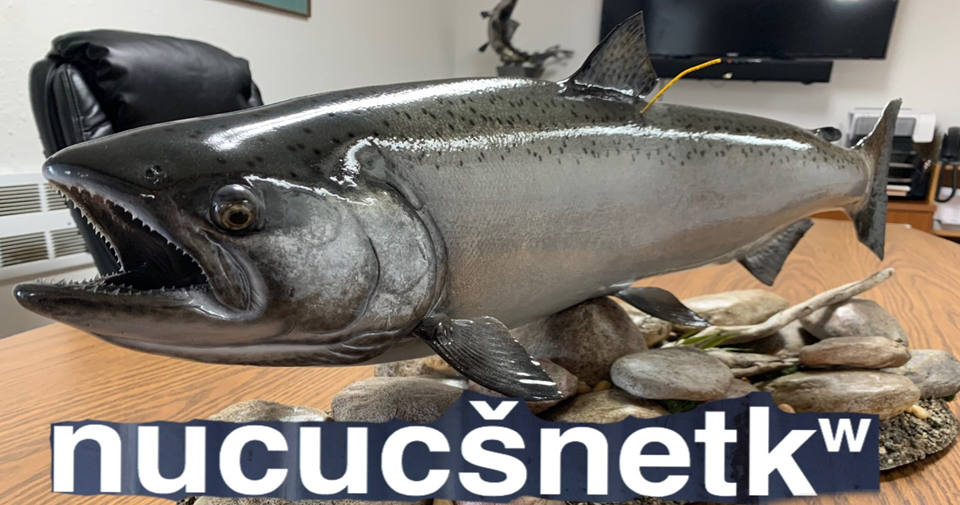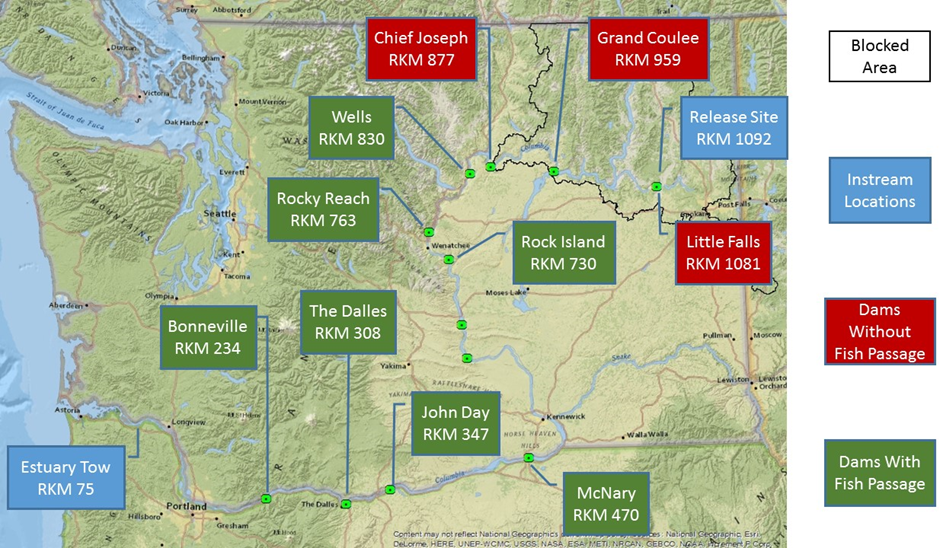“She Who Retraces Her Steps”

In late 2015, 1,000 summer Chinook salmon eggs were received by the Spokane Tribe of Indians (STI). The purpose was to begin restoring the connection between salmon and the STI, begin a Salmon in the Classroom (SIC) program in partnership with on-reservation primary schools, test small-scale rearing equipment, and gain basic behavior and migration information to guide future studies. Eggs and alevins were reared in a rearing facility before a portion were distributed to Wellpinit elementary, middle and high schools. Through 2016 and into 2017 the fish were transferred between several different rearing systems as a means to meet educational goals and accommodate capacity constraints.
In March of 2017, 752 juvenile summer Chinook salmon survived rearing and were marked by implanting Floy and PIT tags. On April 16th, 2017, these yearling summer Chinook were released into Tshimakain Creek, a tributary to the Spokane River on the STI Reservation. Marking these fish enabled their detection via PIT tag arrays in local tributaries, angler creel and standardized fisheries surveys, and juvenile fish passage systems at Columbia River dams downstream of Chief Joseph.
Of the 752 chinook in the release group, 12 were harvested upstream of Grand Coulee Dam with 1 being harvested from Rufus Woods. PIT tag detections from arrays in Lake Roosevelt tributaries and those collected via creel surveys were queried between April 16, 2017 and August 1, 2019. None of the Chinook from the release group were detected in any tributaries with arrays monitored by STI, CCT, or WDFW. The creel survey encountered two chinook, however they were not identified as being part of the release group and are assumed to have been ‘wash downs’ from Lake Coeur d’Alene or from SIC releases performed by the Colville or Coeur d’Alene Tribes. Accounting for harvest and potentially residualized chinook, the remaining 740 fish remain unaccounted for (Table 1).
Table 1. Number of juvenile chinook from the 2017 release group (n=753) that were later documented within the Blocked Area, harvested, or unaccounted for.

Spokane Tribal Fisheries staff generated regular reports from the Columbia Basin PIT Tag Information System (PTAGIS.org), querying detection sites throughout the Columbia River for Chinook from the Tshimikain Creek release group. A total of 90 individuals were detected downstream of Chief Joseph Dam since the time of release (April 16, 2017). The majority of fish detected (75) were juveniles as they used fish bypass facilities at Columbia River hydroelectric dams. Of these, 26 chinook were detected at or downstream of Bonneville Dam. Six other chinook exhibited precocious behavior, migrating back upstream through adult fishways before reaching the Pacific Ocean. Three tags were recovered from avian colonies along the Columbia and estuary (Table 2).
Table 2. Number of individual fish detected downstream of Chief Joseph Dam, among various types of observations in 2017.

Detection efficiencies at juvenile passage systems is not 100%, so the fish that are detected only represent a proportion that actually passed by a particular location. Fish managers use tools within PTAGIS to extrapolate the data to generate survival and travel time estimates for salmon populations throughout the Basin. However, this was not possible for the Tshimikain Creek chinook due to the relatively small release group and low number of detections. This is unsurprising given the journey these fish embarked on. Tshimikain Creek is approximately 1,092 river kilometers from the mouth of the Columbia River. To reach the Pacific Ocean these 75 chinook migrated through an impounded section of the Spokane River, 133 kilometers of storage reservoir (Lake Roosevelt), and over or through three hydroelectric dams that lack fish passage (Little Falls, Grand Coulee, and Chief Joseph); all before reaching the anadromous zone of the Columbia where they encountered nine additional mainstem dams, which are equipped with fish passage. The fact that 90 chinook were detected below Chief Joseph Dam is a testament to their resilience.

Figure 1. Migratory corridor for 2017 release group of yearling summer/fall Chinook. Includes key locations and hydroelectric dams. Wanapum and Priest Rapids Dams in the mid-Columbia are not labeled as no detections were documented at these projects.
The majority of detections occurred between the time of release, April 16, 2017 and August 26, 2017. Travel time for chinook reaching Bonneville Dam or the estuary averaged 63 days. One fish was detected much later…
On June 30, 2019, one of the Chinook from the release group was detected in a Bonneville Dam fish ladder. Over the course of the following two weeks it surmounted every mainstem dam on the Columbia. By July 15th, the King summited the last fish ladder on the Columbia, Wells Dam, just in time for the opening of the recreational summer Chinook fishery in the upper Columbia. Spokane Tribal Fisheries contacted colleagues at the Colville Tribe, requesting them to look for the Tshimikain Chinook during their subsistence fishery and collections at Chief Joseph Hatchery. As the month wore on and no further detections were received, we took solace in the fact that a chinook from Tshimikain, blessed with prayer and song, having followed the path of its ancestors, a path not taken in more than a century, bearing the hopes and dreams of generations present and future, endeavored past turbines and terns, pike and pikeminnow, sealions and gill nets and purse seins, through warm water and over concrete, to as close to its reservation as it could of its own volition.
Ultimately she found her way home. Two weeks after its last detection at Wells Dam, we received a call from the Chief Joseph Hatchery. The Tshimikain Chinook found its way to the Chief Joseph Hatchery ladder, climbing a few steps closer to home while the Colville Tribe collected its brood stock. Several constraints prevented managers from transferring the fish alive, and releasing it to its home waters. But its body was received, its flesh preserved, and its remains returned to the stream. This fish will be commemorated in the administration office of the Spokane Tribe to nurture the hopes and dreams of the membership, symbolizing what is possible, and what is to come.